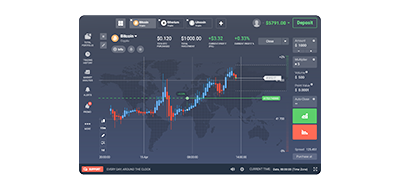Back
Contents
What is the ADX Indicator and How to Use It?

Vitaly Makarenko
Chief Commercial Officer

Demetris Makrides
Senior Business Development Manager
The average directional index (ADX) indicator serves as a tool for assessing the strength of a market trend focusing on its intensity rather than its direction, whether upward or downward. Traders highly value the ADX indicator for its reliability and versatility using it frequently in markets, like stocks, futures and mutual funds.
Reading the ADX Indicator
The ADX is shown as a single line that extends from zero to one hundred. Indicating the strength of a trend irrespective of whether prices are going up or down, ADX is a non-directional indicator.
Comprising three lines—the ADX line, the +DI Positive Directional Indicator and the DI Negative Directional Indicator—a reading above 25 signals a trend while below 25 suggests a trend or sideways movement within a specific range.
The ADX indicator produces a line that faithfully represents the trend’s intensity and amplitude. With a score over 25, a significant strong trend is shown. The trend can be moving upwards or downwards, depending on the relative positions of the +DI and -DI lines. Once the ADX score drops below 0 traders should proceed with caution. This often suggests that the market has begun moving in a weak trend or has entered range-bound movement. Traders would be wise to disregard such signals and steer clear of market trend-based trading tactics in light of the current circumstances.
As a result, traders extract trading signals from the interaction of the +DI and -DI lines. If the ADX line is rising and the +DI line has beyond the -DI line, traders may assume that an uptrend is about to begin. The inverse is also true: when traders see the -DI line rising above the +DI line and the ADX line falling, they interpret this as the start of a downtrend.
ADX’s Limitations
Although the ADX indicator has several beneficial applications, it is crucial to acknowledge its limits. As previously said, it is a lagging indicator, which means it depends on historical price data and movements. Consequently, it does not promptly react to changes and shifts in market conditions. This problem can lead to missed signals or delayed entries, especially in volatile markets with many quick movements.
And as stated above, since the ADX does not show the market direction, only the strength, it needs to be used with other indicators in order to find insight into market and trend direction. Also, trying to sort out and figure out the ADX line and its interaction with the +DI and the -DI lines can be tricky. It does take some experience and a good understanding of the market to effectively wield this ADX and understand its reading in the context of the market.
Using the ADX Indicator
There are numerous uses for the ADX indicator beyond only helping traders gauge trend strength. When paired with other indicators, it gives traders the ability to get a great deal of helpful information that may assist them in improving their strategies for entering and exiting trades. An application of the ADX indicator concerns a pattern of divergence.
This happens when ADX is showing a trend in one direction but the price of an asset moves in the other direction. This means a possible coming shift in the intensity of the trend. If a trader sees a price that is going up for a specific asset but it is together with a declining ADX line, this is a potential indication that the upward trend is ending. Consequently, they may consider it an opportune moment to secure gains from the trade.
When trying to determine whether a breakout is false, traders often use the ADX. Market makers often use false breakouts as a deceptive tactic, particularly in highly volatile markets like the crypto market. The price action can be strong enough to go through support or resistance levels, then turning around and going back. Opening a trade based on a false breakout may result in significant financial losses. However, the ADX indicator can be used to mitigate this risk.
Prior to initiating a transaction, a trader might look at the ADX number. If the reading is below 25, it indicates that the breakout is likely to be fake and the market lacks the necessary strength to sustain it. This suggests that a reversal is probable. Alternatively, if the trader observes a reading above 25, indicating a robust market trend, they might enter a position with more assurance, anticipating the market’s continued momentum.
Bottom Line
The ADX indicator is an effective tool for accurately assessing the strength of a market trend when used appropriately. Just like any other tool, instrument, and indicator, the ADX indicators work better when combined with other tools. This will allow for a more complete market overview and better decisions. Traders that are able to learn, understand, and apply this indicator, along with its strengths and weaknesses, can make trades with confidence and accuracy, leading to more profits and a better bottom line.
Updated:
December 19, 2024

